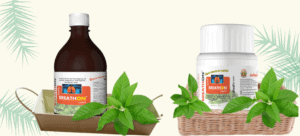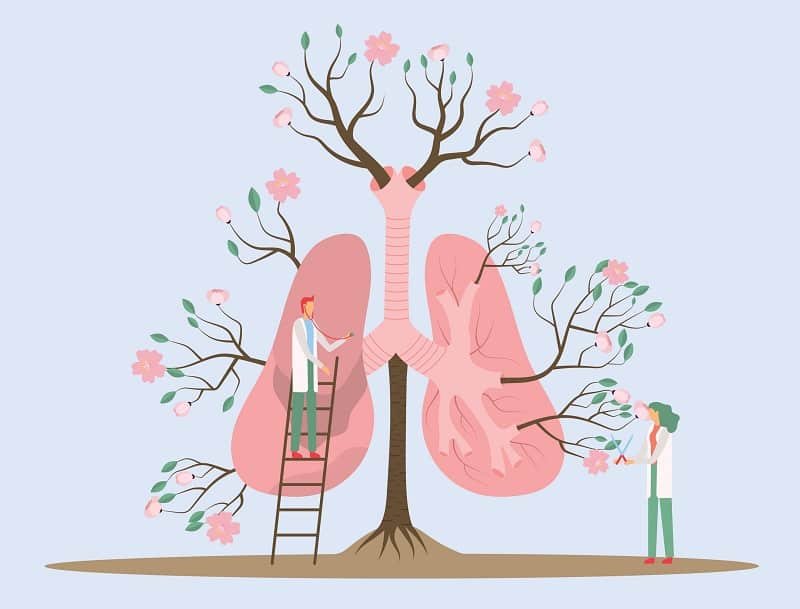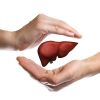Overview
Breathing is an on-granted phenomenon of living organisms. But we should take care of our respiratory system to breathe well, which is the most essential characteristic to be considered as we are living beings. Air-borne infections often attack our respiratory system and breathing difficulty is a common symptom. Ignorance of our respiratory health can cause chronic obstructive pulmonary disease (COPD), the third leading cause of death worldwide. [1]
According to the World Health Organization (WHO), 65 million people across the globe are suffering from COPD and 3 million among them die every year. Globally almost 334 million people have asthma; among them 14% are children. [1] Asthma becomes a global health concern as many patients are found unresponsive to current treatment modalities including corticosteroids. [2] Numerous patients also discontinue conventional treatment. They are worried about adverse effects related to long-term steroid treatment and search for alternative medicine.
Annually millions of people, especially children under five years die because of pneumonia. Tuberculosis (TB) is one of the most common lethal infectious diseases, kills more than one million people every year, though the number of sufferers crosses ten million. Every year, 1.6 million people kill due to lung cancer. Four million impulsive deaths occur due to chronic respiratory disease. [1]
The reasons for developing respiratory disorder are indoor toxic smoke, outdoor pollutant air, tobacco smoke, and allergic reaction to the seasonal changes. [1] The purpose of mentioning this data is to call attention to taking care of our respiratory health. People should not ignore respiratory disorders, and take necessary precautions, and follow care and cure remedy at a very early stage of respiratory infections.
Types of respiratory infections
Broadly respiratory infections are classified as upper respiratory tract infections and lower respiratory tract infections.
Upper respiratory infections
Common cold, pharyngitis, sinusitis, epiglottitis, and laryngotracheitis are examples of upper respiratory infections. Either viral or bacterial invasion leads to different upper respiratory infections. Inhalation of droplets by an individual gives entry to the infectious organisms which are then invading the respiratory mucus layer. This can cause damage of the epithelial layer along with redness, hemorrhage, edema, and worsens the condition.
The common symptoms associated with upper respiratory tract infections are cold, cough, stuffy and runny nose, sneezing with or without fever. Children who are suffering from epiglottitis (swollen epiglottis) usually have a common complaint of breathing difficulty, obstruction of the windpipe (stridor), muffled speech, and drooling.
Severe inflammation of the larynx and trachea in children (croup/ laryngotracheitis) can obstruct the windpipe, rapid breathing (tachypnea), and cyanosis (poor circulation or inadequate oxygenation supply makes skin bluish).
Lower respiratory tract infections
Entering the infectious agent through inhalation and reaching to distal airway causes lower respiratory tract infections. Bronchiolitis, bronchitis, and pneumonia come under lower respiratory tract infections. Both viral and bacterial infections can cause lower respiratory infections. Bronchiolitis and bronchitis are usually occurred due to viral infection. Streptococcus pneumonia is a common bacterial infection responsible for pneumonia. Some other bacterial and viral infections can cause pneumonia also.
Pathogens reproduce in the epithelium after reaching the distal airway. Consequently, mucus secretion increases, and mucociliary function become impaired. Lung functions gradually get affected. Epithelium tissue becomes inflamed. Cell death may occur leads to airway obstruction in case of severe bronchiolitis.
The common symptoms of lower respiratory tract infections are cough, chest pain, fever, rapid breathing, and increase sputum production. Headache, myalgia, confusion, nausea, vomiting, abdominal pain, and diarrhea may occur as additional non-respiratory symptoms in pneumonia.
Antibacterial substances are an effective measure to prevent and care for both upper and lower respiratory tract infections. [3]
The role of Gomutra in prevention, care, and cure of respiratory health
The cow has been considered a sacred animal in Hinduism. Gomutra (cow urine) is compared to nectar in Rigveda (10/15). Gomutra can remove all the imbalances in the body to maintain general health. [4] Dr. Satish Namboodiri (director of Dhanwanthari Vaidyasala, Thodupuzha) agreed that Gomutra is an effective treatment of several major ailments including asthma. [5] Gomutra has the following therapeutic benefits which help to treat the respiratory illness:
- Gomutra has broad-spectrum antibacterial properties and effective against both Gram-negative and Gram-positive bacteria. Gomutra is also effective against some drug-resistant bacteria. The antibacterial mechanism of action of Gomutra can be explained as a significant reduction of pH, along with chloride, phosphorus, and dimethylamine compositions of Gomutra may exert antibacterial property. Long-term storage of Gomutra can produce some reactive compounds like formaldehyde, ketones, amines, and sulfinol which act against bacteria. Gomutra prevents antibacterial resistance development by blocking a plasmid genomic factor (R-factor) of bacteria. [4]
- Gomutra acts as a bio-enhancer which means it can promote or boost biological activity and bioavailability of other therapeutic agents in combination therapy. [6] Researchers have found that Gimutra enhances the activity of some antimicrobial drugs. [4]
- Gomutra is an effective remedy for individuals who have breathing difficulties due to hypersensitivity reactions. [4]
- Modern scientific research evidence has supported that Gomutra has an immune-enhancing ability along with other therapeutic benefits. [4] The immunity-boosting property of Gomutra is significant by daily consumption. Swarn kshar present in Gomutra can improve immunity. Allantoin in Gomutra accelerates the wound healing process.
- Gomutra facilitates the synthesis of different immune system mediators like augments B – and T- lymphocyte blastogenesis, interleukin-1 and -2, and IgA, IgM, and IgG antibody titers to enhance the immunocompetence. [4]
- Gomutra containing uric acid and allantoin has antioxidant properties. The antioxidant property of Gomutra scavenges free radicals and prevents aging. It also helps in repairing DNA damage.
- The antioxidant property of Gomutra reduces apoptosis in lymphocytes and increases their survival rate. Gomutra also gives protection from cancer development due to its anticancer property. [4]

The role of Vasaka in respiratory disorders
Adhatoda vasica is a scientific name of Vasaka, a well-established medicinal plant. The alkaloids present in the Vasaka plant exert therapeutic benefits in the respiratory system. [7]
- Vasaka formulation enhances salivation and gives a soothing effect on the throat, and relieves throat irritation. [8]
- Vasicine and vasicinone alkaloids present in Vasaka leaves specifically acts as a bronchodilator and tracheal muscle relaxant. [7, 8]
- Chronic airway inflammation due to the excessive release of pro-inflammatory immune mediators like eosinophils and lymphocytes (CD4+ Th2) leads to airway hypersensitivity, which causes asthma. Alkaloids present in Vasaka decrease Th2 cytokine secretion and eosinophilia associated with asthma. [9] Vasaka leaves can also relieve cough and liquefied sputum that help to treat asthma. [7]
- Vasaka has an anti-allergic effect by blocking the histamine release. Thus this herbal ingredient can help to provide comfort in an acute allergic asthmatic attack. [7]
- A preclinical research result reported that oral administration of Vasaka extract could increase airway resistance and reduce swelling in acute allergic asthmatic. This research study result indicates that severe steroid-resistant asthma patients can get relief from Vasaka treatment. [10]
- Severe asthma attack elevates hypoxia (oxygen deprivation). A research result found that the anti-asthmatic effects of Vasaka could inhibit the hypoxic response. [2]
- Vasicine alkaloid and high phenolic content of essential oils present Vasaka leaves offer antimicrobial and antimycobacterial activities. [11]
- Phytochemicals present in Vasaka have anti-tuberculosis properties also. [12]
- Respiratory congestion often causes sleep disturbance. Essential oils present in Vasaka leaves contain ketone, terpene, and phenolic ether have sedative effects. [11]
- Researchers also expected that Vasicine possesses a cytotoxic effect and may provide therapeutic benefits against lung cancer. [11]
Shop the cow urine/gomutra for breathing products here.
References
- https://www.who.int/gard/publications/The_Global_Impact_of_Respiratory_Disease.pdf
- https://www.biorxiv.org/content/10.1101/2020.04.01.019430v1
- https://www.ncbi.nlm.nih.gov/books/NBK8142/
- https://www.ncbi.nlm.nih.gov/pmc/articles/PMC4566776/
- https://economictimes.indiatimes.com/cow-urine-aids-treatment-of-cancer-asthma/articleshow/14831895.cms?from=mdr
- https://www.researchgate.net/publication/320163094_REVIEW_ARTICLE_BENEFITS_OF_COW_URINE_-_A_REVIEW
- https://www.researchgate.net/publication/242580337_Characterization_of_an_Expectorant_Herbal_Basak_Tea_Prepared_with_Adhatoda_vasica_Leaves
- https://www.ncbi.nlm.nih.gov/pmc/articles/PMC3202261/
- https://link.springer.com/article/10.1007/s00044-014-0996-y
- https://pubmed.ncbi.nlm.nih.gov/33565386/
- https://www.ncbi.nlm.nih.gov/pmc/articles/PMC4303024/
- https://www.plantsjournal.com/archives/2017/vol5issue1/PartC/5-1-29-276.pdf




Leave a reply